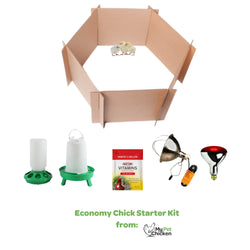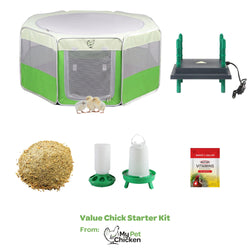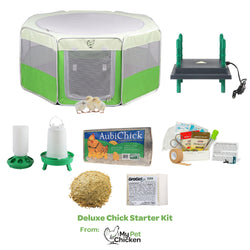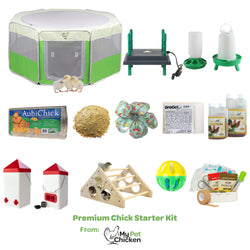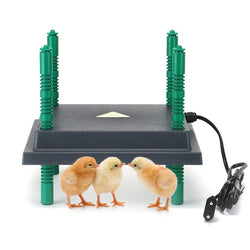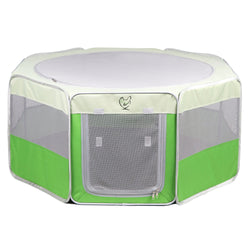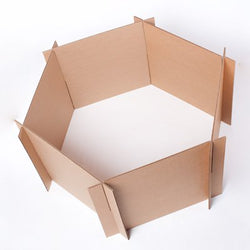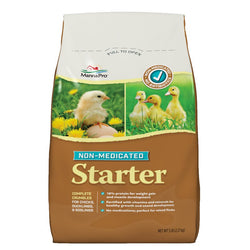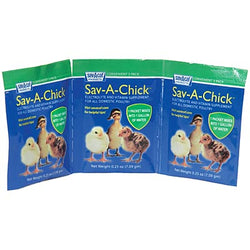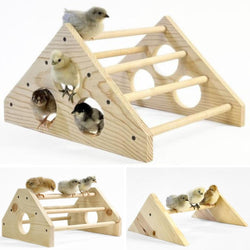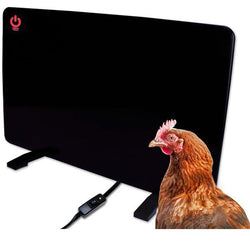What is a dual-purpose chicken?
Back to blog
In the modern day, factory farm chickens are kept for laying or meat production. Laying breeds, or "layers," tend to produce impressive quantities of large eggs and use most of their resources for egg production. Layers may also be called "production breeds," because they are kept specifically for the purpose of egg production.
By contrast, "meat birds," often called "broilers," are large-bodied and grow extraordinarily fast. Many are just 6 weeks old when they are processed. "Processed" is a nice way of saying, "killed and butchered for market."
So, a dual-purpose breed is generally regarded as a chicken breed that lays a good number of eggs but is still large enough to process extra roosters and older hens, and take to market. (You can, of course, eat any size of chicken you choose, but in today's grocery stores you see large, fat birds). Having two different types of birds is not how it always was, though. In homesteading and hobby flocks, that's STILL not usually how it is.
"Dual-purpose" terminology is a bit inaccurate. Backyarders don't tend to want to process their birds. Even so, dual-purpose breeds are among the most popular for backyard flocks. That's mostly because the larger birds tend to be less flighty. They can still get startled, of course, but with their heavy bodies, they don't usually fly over fences. And in cold winter areas, their larger size makes it easier for them to bear the cold. A better word for "dual-purpose" is probably "utility breed."
Another thing we really don't like about the term "dual-purpose" is that it suggests a false dichotomy, as if there are only two possible reasons for keeping chickens: eggs or meat. We can think of two more:
1. Ornamental breeds are kept for beauty or for exhibition at poultry shows. They may not lay well---and they may not be large, either. For example, the Polish is an ornamental breed. They don't lay well, and they're small and skinny. However, they're flamboyant, with their huge crests!

2. Pet chickens may be from any breed and are kept for companionship, fun, or whatever reasons are important to the chicken keeper. We think all chickens are beautiful, but they don't have to have particularly stunning ornamental qualities, be large enough to eat, or lay especially well to be friendly and affectionate and to make excellent pets. For example, bantam Easter Eggers (below) are essentially "mutts" that lay colored eggs. Because they're mutts they can't be shown except in specific categories for backyard birds and mixes. Easter Eggers lay fair numbers of eggs, but aren't known for winter laying. Plus, bantam eggs are quite small.

So bantam Easter Eggers are a breed you would probably keep just because they're fun and friendly, with the little blue and green eggs being a nice novelty. Most people probably aren't keeping them with the primary purpose of producing meat or large numbers of eggs--or because they want to win poultry exhibitions! Nevertheless, bantam Easter Eggers, like most other chicken breeds, make great pets--with benefits!
To recap, chickens are kept for a variety of purposes: egg laying, meat production, just 'cause they're cool-looking (ornamental), and because they're great pets.
By contrast, "meat birds," often called "broilers," are large-bodied and grow extraordinarily fast. Many are just 6 weeks old when they are processed. "Processed" is a nice way of saying, "killed and butchered for market."
So, a dual-purpose breed is generally regarded as a chicken breed that lays a good number of eggs but is still large enough to process extra roosters and older hens, and take to market. (You can, of course, eat any size of chicken you choose, but in today's grocery stores you see large, fat birds). Having two different types of birds is not how it always was, though. In homesteading and hobby flocks, that's STILL not usually how it is.
"Dual-purpose" terminology is a bit inaccurate. Backyarders don't tend to want to process their birds. Even so, dual-purpose breeds are among the most popular for backyard flocks. That's mostly because the larger birds tend to be less flighty. They can still get startled, of course, but with their heavy bodies, they don't usually fly over fences. And in cold winter areas, their larger size makes it easier for them to bear the cold. A better word for "dual-purpose" is probably "utility breed."
Another thing we really don't like about the term "dual-purpose" is that it suggests a false dichotomy, as if there are only two possible reasons for keeping chickens: eggs or meat. We can think of two more:
1. Ornamental breeds are kept for beauty or for exhibition at poultry shows. They may not lay well---and they may not be large, either. For example, the Polish is an ornamental breed. They don't lay well, and they're small and skinny. However, they're flamboyant, with their huge crests!

2. Pet chickens may be from any breed and are kept for companionship, fun, or whatever reasons are important to the chicken keeper. We think all chickens are beautiful, but they don't have to have particularly stunning ornamental qualities, be large enough to eat, or lay especially well to be friendly and affectionate and to make excellent pets. For example, bantam Easter Eggers (below) are essentially "mutts" that lay colored eggs. Because they're mutts they can't be shown except in specific categories for backyard birds and mixes. Easter Eggers lay fair numbers of eggs, but aren't known for winter laying. Plus, bantam eggs are quite small.

So bantam Easter Eggers are a breed you would probably keep just because they're fun and friendly, with the little blue and green eggs being a nice novelty. Most people probably aren't keeping them with the primary purpose of producing meat or large numbers of eggs--or because they want to win poultry exhibitions! Nevertheless, bantam Easter Eggers, like most other chicken breeds, make great pets--with benefits!
To recap, chickens are kept for a variety of purposes: egg laying, meat production, just 'cause they're cool-looking (ornamental), and because they're great pets.
